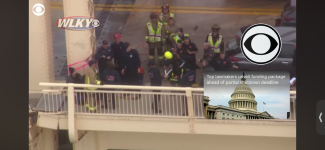Rockbadchild--a question on rigging. Thanks for your explanation; I have no experience in rigging for live evacuations.
In a different video taken from the bridge deck it appeared that a "fall" line ran from somewhere (fixed?) on the bridge deck to a block (A) at the tip of the right rail of the ladder, then down to a movable block (B) from which the rescuer (and victim) was suspended, then up to a block (C) at the tip of the left rail of the ladder. and thence back to the bridge deck. I assumed this was done to equalize the strain on the falls as there likely is some concern that uneven strain might twist the ladder making retraction of the ladder problematic. It would also give an additional 2:1 advantage and reduce the strain on each part by half. Presumably there is a fast acting brake on movable block B should the fall line fail. As the rescuers haul on one line in bcp's video one can see the two "fall" lines move apart from the camera's perspective.

